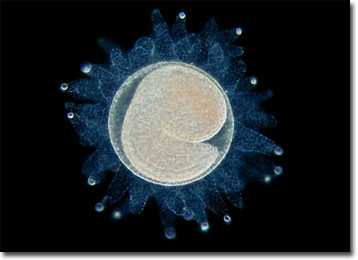Wim van Egmond
Tunicate Larva
Tunicates are small, but widespread, marine animals that belong to the phylum Chordata. Thus, the organisms are related to vertebrates, although little similarity between them can be seen in the adult stage.

Adult tunicates are typically surrounded by a secreted cellulose-containing tunic, from which they gained their name. Sometimes mistaken for sponges, the organisms continuously siphon water through their soft bodies by utilizing two major openings. One of these openings is also responsible for expelling wastes and gametes. Other major features of most tunicate adults include an internal mucus sheath that filters out food particles from the water, a gas exchange system that is largely dependent on gills, a poorly developed musculature, a digestive system, as well as a heart and large blood vessels. The actions of the tunicate heart are, however, somewhat of a mystery to modern scientists. For reasons that remain to be seen, the unusual organ periodically changes the direction in which it circulates blood.
The best-known group of tunicates is the ascidians, commonly called sea squirts. These sedentary, globular creatures expel a characteristic jet of water when they are disturbed and can frequently be found attached to a variety of substrates, including rocks, wharves, and boats. Other types of tunicates, however, may be planktonic, swimming or floating freely through the oceans. Colonial forms are also common, and one group, called the larvaceans, retains the characteristics of larvae as adults. Reproduction is typically sexual and most tunicates are hermaphrodites.
It is in the larval form that tunicates reveal their ancient relationship to humans and other vertebrates. During this brief stage of life, the developing organisms exhibit a sort of primitive, flexible backbone called a notochord. Also, a nerve cord runs down their relatively long, muscular tails, which help propel them through their aquatic environment once they are released from their eggs. Gravity and light-sensing vesicles are also present in the larval stage, providing important information regarding orientation to the tadpole-shaped organisms. Their purpose at this point in the life cycle, however, is not to find food, but rather a suitable location for metamorphosis. During this form-changing process, the larval tail is resorbed as a food source and the notochord is lost.
BACK TO WIM VAN EGMOND GALLERY
